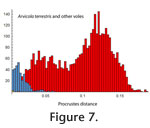|
|
|
ConclusionsThe proportion of environmental variance identified through fluctuating asymmetry was relatively small (11.0%-28.5% of the total variance), implying that heritabilities (h2) of tooth shape range from 0.71 to 0.89. These h2 values are somewhat higher than in previous studies of heritability in dental characters, but not surprisingly so. Leamy and Bader (1968) found h2 values that ranged between 0.60 and 0.66 for the linear size of field mouse molars. Hlusko and Mahaney (2003) found h2 to be as high as 0.725 for the presence of cingular remnants in baboon molars, though in most cases h2 was around 0.60 for that trait.
Arvicoline rodents may have especially variable teeth, and they may vary within species and between species, but the magnitude of variation between species is so much greater than that within species that variation is not likely to confound palaeontological interpretations. The amount of ecophenotypic environmental variance within the species we measured appears to be negligible compared to the differences we observed between species. |
|
